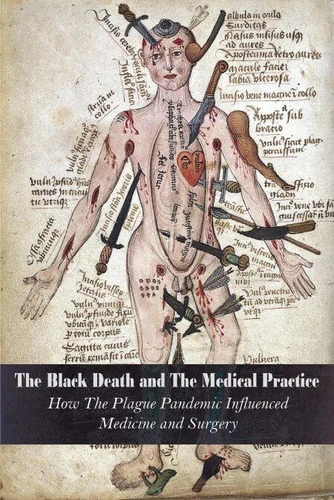The Black Death and The Medical Practice How The Plague Pandemic Influenced Medicine and Surgery
Par :Formats :
Disponible dans votre compte client Decitre ou Furet du Nord dès validation de votre commande. Le format ePub est :
- Compatible avec une lecture sur My Vivlio (smartphone, tablette, ordinateur)
- Compatible avec une lecture sur liseuses Vivlio
- Pour les liseuses autres que Vivlio, vous devez utiliser le logiciel Adobe Digital Edition. Non compatible avec la lecture sur les liseuses Kindle, Remarkable et Sony
 , qui est-ce ?
, qui est-ce ?Notre partenaire de plateforme de lecture numérique où vous retrouverez l'ensemble de vos ebooks gratuitement
Pour en savoir plus sur nos ebooks, consultez notre aide en ligne ici
- FormatePub
- ISBN8201874599
- EAN9798201874599
- Date de parution07/08/2021
- Protection num.pas de protection
- Infos supplémentairesepub
- ÉditeurJL
Résumé
The Black Death was an infamous plague causing an estimated 20 million deaths in Europe. Its spread and impact are disputed, but it gives insight into a medieval way of life. Medieval European medicine was very different from our modern concept of medicine. There was no knowledge of germs and only relatively basic tools to diagnose and treat illness. Much of medicine was, at best, based on ancient Roman and Greek ideas of the 'humor.' The idea was to balance specific fluids known as 'black bile, ' 'yellow bile, blood, and phlegm (the fluids made by your ear, nose, and throat).
To be in bad or good humor was evidence of how healthy you were! Other doctors would release "evil spirits" by trepanning (drilling a hole in your head to release them). In the 1347-1350 outbreak, doctors were utterly unable to prevent or cure the plague. For those who believed in Greek humor, there was a range of cures available. 'Blood-letting' - deliberately bleeding a vein - was a way of reducing 'hot' blood, while blowing your nose or clearing your throat was a way of getting rid of too much 'cold' phlegm.
Mustard, mint sauce, apple sauce, and horseradish were used to balance wet, dry, hot, and cold in your diet!This book will focus on the effects of the Black Death on medicine and medical practice in Europe. Its purpose is to investigate the Black Death's influence on treatment, especially concerning learned medicine and surgery.
To be in bad or good humor was evidence of how healthy you were! Other doctors would release "evil spirits" by trepanning (drilling a hole in your head to release them). In the 1347-1350 outbreak, doctors were utterly unable to prevent or cure the plague. For those who believed in Greek humor, there was a range of cures available. 'Blood-letting' - deliberately bleeding a vein - was a way of reducing 'hot' blood, while blowing your nose or clearing your throat was a way of getting rid of too much 'cold' phlegm.
Mustard, mint sauce, apple sauce, and horseradish were used to balance wet, dry, hot, and cold in your diet!This book will focus on the effects of the Black Death on medicine and medical practice in Europe. Its purpose is to investigate the Black Death's influence on treatment, especially concerning learned medicine and surgery.
The Black Death was an infamous plague causing an estimated 20 million deaths in Europe. Its spread and impact are disputed, but it gives insight into a medieval way of life. Medieval European medicine was very different from our modern concept of medicine. There was no knowledge of germs and only relatively basic tools to diagnose and treat illness. Much of medicine was, at best, based on ancient Roman and Greek ideas of the 'humor.' The idea was to balance specific fluids known as 'black bile, ' 'yellow bile, blood, and phlegm (the fluids made by your ear, nose, and throat).
To be in bad or good humor was evidence of how healthy you were! Other doctors would release "evil spirits" by trepanning (drilling a hole in your head to release them). In the 1347-1350 outbreak, doctors were utterly unable to prevent or cure the plague. For those who believed in Greek humor, there was a range of cures available. 'Blood-letting' - deliberately bleeding a vein - was a way of reducing 'hot' blood, while blowing your nose or clearing your throat was a way of getting rid of too much 'cold' phlegm.
Mustard, mint sauce, apple sauce, and horseradish were used to balance wet, dry, hot, and cold in your diet!This book will focus on the effects of the Black Death on medicine and medical practice in Europe. Its purpose is to investigate the Black Death's influence on treatment, especially concerning learned medicine and surgery.
To be in bad or good humor was evidence of how healthy you were! Other doctors would release "evil spirits" by trepanning (drilling a hole in your head to release them). In the 1347-1350 outbreak, doctors were utterly unable to prevent or cure the plague. For those who believed in Greek humor, there was a range of cures available. 'Blood-letting' - deliberately bleeding a vein - was a way of reducing 'hot' blood, while blowing your nose or clearing your throat was a way of getting rid of too much 'cold' phlegm.
Mustard, mint sauce, apple sauce, and horseradish were used to balance wet, dry, hot, and cold in your diet!This book will focus on the effects of the Black Death on medicine and medical practice in Europe. Its purpose is to investigate the Black Death's influence on treatment, especially concerning learned medicine and surgery.





